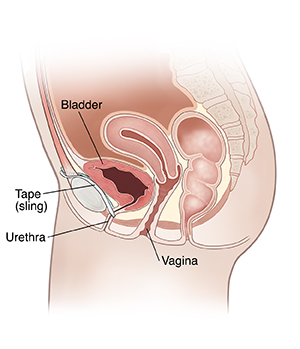Stress Urinary Incontinence: Having Midurethral Sling Surgery
Stress Urinary Incontinence: Having Midurethral Sling Surgery

How should I prepare for surgery?
The weeks before surgery
Have any tests that your doctor orders.
Tell your doctor about aspirin and other medicines, vitamins, or herbs you take. Ask if you should stop taking them before surgery.
Stop smoking to help lower your risks during surgery.
If you have been given any prescriptions to fill, do this before surgery.
The night before surgery
You may be asked to give yourself an enema. This cleans out your bowels for surgery. You’ll be told how to do it.
Follow any directions you are given for taking medicines and for not eating or drinking before surgery.
The day of surgery
Arrive at the hospital a few hours before surgery as directed. Have someone drive you there who can also stay during the surgery, and drive you home. At the hospital, the healthcare staff will take your temperature and blood pressure. In some cases, you may have tests. Then the healthcare staff will put in one or more IV (intravenous) lines. These lines give you fluids and medicines before, during, and after surgery. Some of your pubic hair may be removed. The staff may put tight stockings on your legs to help prevent blood clots.
About anesthesia
To keep you pain-free during surgery, you’ll get anesthesia. General anesthesia lets you sleep during the surgery. Local anesthesia numbs the area that will be operated on. Before surgery, you’ll meet with the anesthesiologist or nurse anesthetist. He or she can tell you what kind of anesthesia you will get and answer questions you may have.
What happens during the procedure?
The surgeon will make 2 small cuts (incisions) in the lower part of your belly (abdomen), near the pubic hairline or in the inner upper part of your thighs. He or she will make another small incision in the front wall of the vagina.
The surgeon will work through the incisions to place the tape like a hammock under the urethra. The two ends of the tape emerge through the incisions.
If you’re given local anesthesia, your surgeon may tell you to cough so that the tension of the tape can be changed.
When the tension is changed, the ends of the tape are cut. They stay below the skin in the tissue of the abdominal wall. The healing process of the incisions holds the ends of the tape in place.
The surgeon will close the incisions in the abdomen and vagina with stitches (sutures).
What are the risks and complications?
The risks and complications of this procedure may include:
Infection
Bleeding
Risks of anesthesia
Blood clots
Damage to nerves, muscles, bladder, or nearby pelvic structures
Trouble urinating
Urinary urgency
Problems with sling (tape)
Updated:
June 21, 2018
Reviewed By:
Brown, Kim, APRN,Greenstein, Marc, DO,Image reviewed by StayWell medical illustration team.